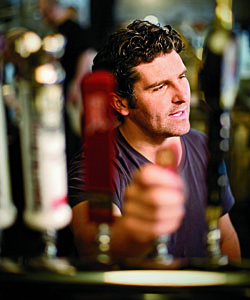Interview by Marcia Froelke Coburn

You’ve opened a doughnut shop and three restaurants in two years, with two more—Bavette’s, a steak place, and a Neapolitan pizzeria—on the way. Are you afraid of oversaturating the market?
Definitely not. If you’re delivering a quality product, there’s not going to be a problem. I don’t want to overextend, so while we’ve come out of the gate very quickly, we’re going to slow down now. I want to continue to provide opportunities for the employees. We attract very talented people. I want to keep them with us.
You must work all of the time. Where do you hang out after-hours?
I’m usually up early working, then I go home and take a nap in the afternoon. I’ll end up back at one of the restaurants—not any particular one regularly—around 9:30 p.m. and stay until 2 or 3 a.m.
Are you single?
I’m not married. That’s my answer.
A pizza joint, a doughnut shop, and a diner that specializes in burgers—every place is different, but they all draw crowds. What are the essential ingredients to your restaurants?
Attention to detail. That’s the most important thing. The components that make a restaurant work are simple: Think of your senses. How does it look? Feel? Sound? What’s the temperature? What does the person you’re with look like in the light there? And, of course, how is the food? Is this a place I would want to eat in three times a week?
What culinary genre would you never explore?
I’d never say never.
What is the single most important lesson that you learned working as a creative development chef for Lettuce Entertain You founder Rich Melman?
Connecting a restaurant space to the people who eat there. Prior to working with Rich, my experience was totally fine dining. [Sodikoff worked as a cook for Thomas Keller at The French Laundry and for Alain Ducasse.] You would go to those restaurants because they are out of your comfort zone and you want a new experience. But I want people to be able to walk in and feel at home immediately. Rich taught me to take my skill set—extracting flavors, food presentation, knowledge of drinks—and learn how to tell a story with it. That way, you connect it to people as soon as they walk in the door.
How did you bankroll your first venture, Gilt Bar, in 2010? How much of your personal cash did you put on the line?
I put everything I owned on the line. I’m not comfortable discussing the investment amount. My family supported me a bit in the venture. Along with a very small group of people, I did demo, put up the walls, painted. We did just enough to get open and then put everything back into the business. It was scary for a while.
In the restaurant business, certain locations where good restaurants have failed are considered snakebit. But you’re not afraid of those locations. An example is Gilt Bar.
I don’t really believe in the jinxed idea. If there is a lot of crime in a neighborhood, that can be a problem. But the best way to improve a neighborhood is to put in a restaurant that people want to go to. I look for those locations. I live in River North, and if I can walk to a place on a moderately warm or cold day, it’s a good location. It’s that simple.
Do you miss putting on an apron and getting in the kitchen?
I still do it sometimes. I like to mentor and teach, so it’s gratifying to me to teach someone how to do a dish.
Which Chicago venture has yielded the greatest profit margin so far?
Doughnut Vault. Definitely the greatest return on investment. The original investment was $45,000. Now we make 1,000 doughnuts a day, and when we’re sold out, we close until the next day.
What’s your answer to those who call you an overnight sensation?
I didn’t know people said that. Maybe for them it was overnight, but for me it’s been a very long time. I started working in the industry when I was 15 years old. Anyone who says that doesn’t know me well.
People stand in line forever at Doughnut Vault. At Maude’s Liquor Bar on the weekends, the wait for a table can be three hours. What have you stood in line for?
I don’t like lines. I feel bad about the line at Doughnut Vault, and I called the city to see if I could sell doughnuts out of a Dutch-style bike to help cut the lines. But they said no, it had to be a motorized vehicle. Years ago, I was going to meet Julia Child and I stood in line to do that. I ended up with a pen-pal correspondence with her.
Photograph: Chris Strong


